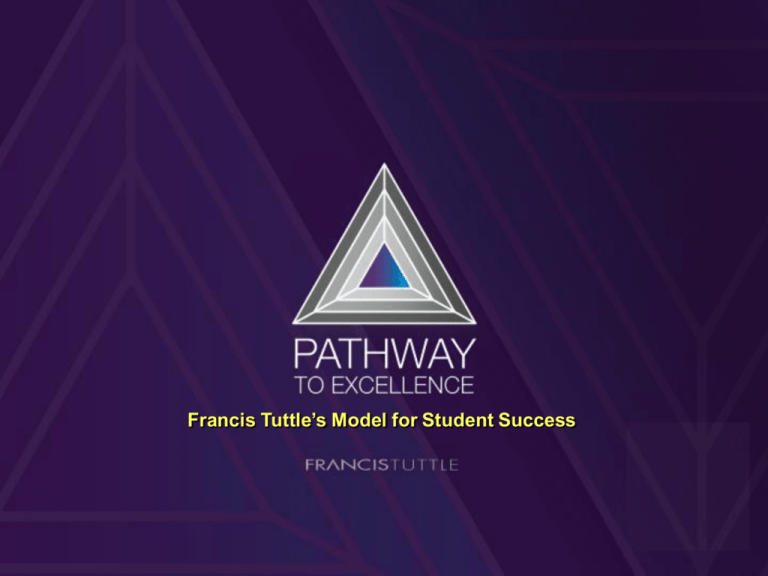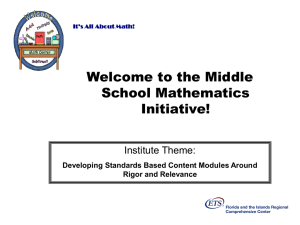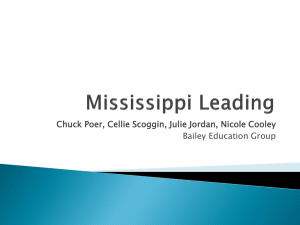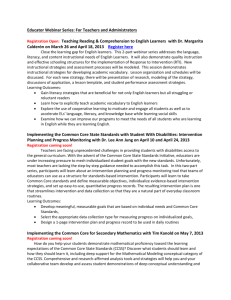P2E R&R Training FINAL - CTE Technical Assistance Center of NY
advertisement

Francis Tuttle’s Model for Student Success Pathway to Excellence Update Michelle Keylon Introduction to the Rigor and Relevance Framework Sherry Adrian © International Center for Leadership in Education What is it? • Tool developed by the International Center for Leadership in Education • Framework is based on two dimensions of higher knowledge and student achievement. – Knowledge continuum – Application continuum What is Rigor? • Continual acquisition of new skills and knowledge. • It is derived understanding content that is complex and challenging. © International Center for Leadership in Education What is Relevance? • Skills and knowledge are applied to real- world problems. © International Center for Leadership in Education Why Rigor and Relevancy? • When students experience a problem in context, they are more likely to see the value of what they are learning. © International Center for Leadership in Education © International Center for Leadership in Education Teaching Methods Traditional Rigor & Relevance • Teaching-focused • Learning-focused • Time-based • Competency-based • Interdisciplinary • Fragmented • Textbooks • Routine © International Center for Leadership in Education • Real-world • Challenging Teaching involves demonstrating skills and presenting knowledge, but learning doesn’t occur until students engage and understand. -Bill Daggett Research • Research confirms that greater learning takes place when students are challenged and engaged in their learning. Practice 75% Discussion Demonstration A/V Reading 10% Lecture 5% © International Center for Leadership in Education 50% 30% 20% The Rigor and Relevance Framework © International Center for Leadership in Education Rigor/Relevance Framework 6 Knowledge 5 4 3 2 Application 1 1 2 © International Center for Leadership in Education 3 4 5 Rigor/Relevance Framework 6 5 4 C D A B 3 2 1 1 © International Center for Leadership in Education 2 3 4 5 Knowledge Taxonomy Lisa Schneberger Knowledge Taxonomy 1. 2. 3. 4. 5. 6. Knowledge Comprehension Application Analysis Synthesis Evaluation © International Center for Leadership in Education Knowledge Taxonomy Verb List Can be used to: • Create a desired level of expected student performance. • Evaluate the level of existing curriculum, instruction, or assessment. © International Center for Leadership in Education Knowledge Taxonomy Example #1 Basic Nutrition 1. 2. 3. 4. Label food by nutritional groups Explain nutritional value of individual foods Use nutritional guidelines in planning meals Examine success in achieving nutritional goal 5. Develop personal nutrition goals 6. Appraise results of personal eating habits over time © International Center for Leadership in Education Knowledge Taxonomy Example #2 Roller Skating 1. 2. 3. 4. 5. 6. Identify equipment Explain safety precautions Roller-skate on level ground and hills Examine skills and weaknesses Develop a plan for improvement Assess someone else’s skills © International Center for Leadership in Education ACTIVITY Setting the Level of Knowledge Application Model Marie Howard Application Model 1. 2. 3. 4. Knowledge in one discipline Application within discipline Application across disciplines Application to real-world predictable situations 5. Application to real-world unpredictable situations © International Center for Leadership in Education Application Model Decision Tree Is it Application? If NO If YES, is it real world? o If NO and one discipline o If NO and interdisciplinary o If YES, is it unpredictable? • If NO • If YES © International Center for Leadership in Education Level 1 Level 2 Level 3 Level 4 Level 5 Application Model Example #1 Interviewing Skills 1. 2. 3. 4. List steps in preparing for interview Participate in a mock interview Conduct interview for school-based business Select appropriate apparel and grooming for an interview 5. Interview for a job © International Center for Leadership in Education Application Model Example #2 Public Speaking 1. 2. 3. 4. List characteristics of a good speech Give a presentation to a class Make an oral defense of a completed project Present a point of view on an issue at a public meeting 5. Respond to questions as a student representative at a board of education meeting © International Center for Leadership in Education ACTIVITY Setting the Level of Application Determining Levels of Rigor and Relevance Brenda Chapman Why do you Teach? 1. I have to go somewhere during the day. 2. 3. 4. 5. 6. 7. This is my social life. I enjoy doing follow-up reports. Unlimited supply of coffee. I love office supplies. I want to be the center of attention. It’s the mascot!! The Duck is cool!! Why do you teach? To Stay Younger Break down barriers, keep up on current trends and ideas Autonomy in the Classroom An opportunity to be creative Teaching Helps You Learn a Subject Student questions make you dig deeper for information. Daily Humor Positive attitude and a sense of humor makes the job fun and enjoyable. Affecting the Future –Teachers mold the future each day in class. –You see the students more on a day-to-day basis than their family. Student Success –Drives teachers to continue. –You reach a student that others have written off. Student Potential –You believe every student has potential for success. –Potential is exciting!!! –New challenges. Sometimes we have to go through a little brush… © International Center for Leadership in Education Rigor/Relevance Framework 6 5 4 3 2 1 • • • • Analyze the graphs of the perimeters and areas of squares having different-length sides. Determine the largest rectangular area for a fixed perimeter. Identify coordinates for ordered pairs that satisfy an algebraic relation or function. Determine and justify the similarity or congruence for two geometric shapes. C • Express probabilities as fractions, percents, or decimals. • Classify triangles according to angle size and/or length of sides. • Calculate volume of simple threedimensional shapes. • Given the coordinates of a quadrilateral, plot the quadrilateral on a grid. A 1 © International Center for Leadership in Education 2 • • • • Obtain historical data about local weather to predict the chance of snow, rain, or sun during year. Test consumer products and illustrate the data graphically. Plan a large school event and calculate resources (food, decorations, etc.) you need to organize and hold this event. Make a scale drawing of the classroom on grid paper, each group using a different scale. D • Calculate percentages of advertising in a newspaper. • Tour the school building and identify examples of parallel and perpendicular lines, planes, and angles. • Determine the median and mode of real data displayed in a histogram • Organize and display collected data, using appropriate tables, charts, or graphs. B 3 4 5 © International Center for Leadership in Education Rigor/Relevance Framework 6 5 4 3 2 1 • • • • Analyze the graphs of the perimeters and areas of squares having different-length sides. Determine the largest rectangular area for a fixed perimeter. Identify coordinates for ordered pairs that satisfy an algebraic relation or function. Determine and justify the similarity or congruence for two geometric shapes. • Obtain historical data about local weather to predict the chance of snow, rain, or sun during year. Test consumer products and illustrate the data graphically. Plan a large school event and calculate resources (food, decorations, etc.) you need to organize and hold this event. Make a scale drawing of the classroom on grid paper, each group using a different scale. Quadrant A • • Express probabilities as fractions, • percents, or decimals. • Classify triangles according to angle size and/or length •of sides. • Calculate volume of simple threedimensional shapes. • Calculate percentages of advertising in a newspaper. • Given the coordinates of a • Tour the school building and identify quadrilateral, plot theexamples quadrilateral on of parallel and perpendicular lines, planes, and angles. a grid. • Determine the median and mode of real C B A 1 © International Center for Leadership in Education D data displayed in a histogram • Organize and display collected data, using appropriate tables, charts, or graphs. 2 3 4 5 © International Center for Leadership in Education Rigor/Relevance Framework 6 5 4 • • • • 3 • 2 • • 1 • Analyze the graphs of the perimeters and areas of squares having different-length sides. Determine the largest rectangular area for a fixed perimeter. Identify coordinates for ordered pairs that satisfy an algebraic relation or function. Determine and justify the similarity or congruence for two geometric shapes. • Obtain historical data about local weather to predict the chance of snow, rain, or sun during year. Test consumer products and illustrate the data graphically. Plan a large school event and calculate resources (food, decorations, etc.) you need to organize and hold this event. Make a scale drawing of the classroom on grid paper, each group using a different scale. Quadrant B • Calculate percentages of • advertising in a newspaper. • • Tour the school building and identify examples of parallel and • perpendicular lines, planes, and angles. • Determine the median and mode of Express probabilities as fractions, percents, or decimals. real data displayed in a histogram Classify triangles according to • size Organize angle and/or length and of sides.display collected Calculate volume of simple threedata, using appropriate tables, dimensional shapes. Given the coordinates charts, orof agraphs. C D B A quadrilateral, plot the quadrilateral on a grid. 1 © International Center for Leadership in Education 2 3 4 5 © International Center for Leadership in Education Rigor/Relevance Framework • 6 4 3 • 2 • • 1 Quadrant C • • Analyze the graphs of the perimeters • and areas of squares having different-length sides. • Determine the largest rectangular • area for a fixed perimeter. • Identify coordinates for ordered pairs • Calculate percentages of or advertising in Express that probabilities as fractions, satisfy an algebraic relation a newspaper. percents, or decimals. • Tour the school building and identify Classify function. triangles according to examples of parallel and perpendicular angle size and/or length of sides. • Determine and justify or lines, the planes,similarity and angles. Calculate volume of simple three• Determine the median and mode of real dimensional shapes. congruence for two geometric data displayed in a histogram Given the coordinates of a • Organize and display collected data, shapes. quadrilateral, plot the quadrilateral D C 5 • Obtain historical data about local weather to predict the chance of snow, rain, or sun during year. Test consumer products and illustrate the data graphically. Plan a large school event and calculate resources (food, decorations, etc.) you need to organize and hold this event. Make a scale drawing of the classroom on grid paper, each group using a different scale. B A using appropriate tables, charts, or graphs. on a grid. 1 © International Center for Leadership in Education 2 3 4 5 © International Center for Leadership in Education Rigor/Relevance Framework 6 5 4 • • • • 3 • 2 • • 1 • Analyze the graphs of the perimeters and areas of squares having different-length sides. Determine the largest rectangular area for a fixed perimeter. Identify coordinates for ordered pairs that satisfy an algebraic relation or function. Determine and justify the similarity or congruence for two geometric shapes. Quadrant D • Obtain historical data about local weather to predict the chance of snow, rain, or sun during year. • Test consumer products and illustrate the data graphically. • Plan a large school event and calculate resources (food, • Calculate percentages of advertising in Express probabilities as fractions, a newspaper. percents,decorations, or decimals. etc.)• you need to and identify Tour the school building Classify triangles according to examples of parallel and perpendicular organize and event. angle size and/or length of sides. hold this lines, planes, and angles. Calculate volume of simple three• Make a scale drawing of the • Determine the median and mode of real dimensional shapes. data displayed in a histogram Given the coordinates of a on grid paper, classroom each • Organize and display collected data, quadrilateral, plot the quadrilateral using appropriate group using a different scale.tables, charts, or on a grid. C D A B graphs. 1 © International Center for Leadership in Education 2 3 4 5 Rigor/Relevance Framework K N O W L E D G E Assimilation Adaptation C D Acquisition Application A B APPLI CAT I O N © International Center for Leadership in Education Example Multiple Performances for Single Standard Reading - H.S Level Standard: Identify, collect and/or select pertinent information while reading R/R Student Performance Quadrant A B C D Read science experiment and identify necessary materials to perform experiment. Locate and read a current article on biotechnology. Read and analyze three original newspaper articles from World War II and identify reasons for opposition to US entry into the war. Research pertinent information related to the El Nino weather pattern and propose possible family vacation destinations. © International Center for Leadership in Education Rigor/Relevance Framework Teacher/Student Roles C R I G O R High D Student Think B A Low Student Think & Work Teacher Work Student Work Low High © International Center for Leadership in Education RELEVANCE Rigor/Relevance Framework Did Students Get it Right? C R I G O R High D Rational Answer B A Low Right Questions Right Answer Right Procedure Low High © International Center for Leadership in Education RELEVANCE ACTIVITY Determining Levels of Rigor and Relevance ACTIVITY Rigor and Relevance Challenge Gold Seal LAPs Sherry Adrian LAP Format • • • • • • Instructional Focus Student Learning Essential Skills Performance Tasks Resources Assessments ACTIVITY Determining Levels of Test Questions Linking Standards and Student Work Dana Myers Academic Standards •Benchmarks of quality and excellence in education. Benchmarking started with CareerTech Employers • First used by cobblers to measure people’s feet for shoes. • They would place someone’s foot on a “bench” and mark it out to make the pattern for the shoes. We are a KEY Player when it comes to academic standards • CareerTech provides relevance for academic standards—the AH-HA moment! • Cool jobs that use math Why? • Interdisciplinary approach increases rigor and provides relevance. • Integrating academic standards into LAPs will establish benchmarks that demonstrate our ongoing commitment to quality and excellence in our programs. Getting Started • Identify the Benchmarks – Align existing standards, (Work Keys, National Essential Skills, Common Core Objectives ) to ACT Objectives • Measure results – High school students: Look at PLAN and practice ACT scores. – Adult students: Look at COMPASS scores. Teacher Committee • Your involvement is needed to help determine the most appropriate standards to use to showcase how we integrate academics into our LAPs. Academic Standards Benchmarks of quality and excellence in education. What’s Next Sherry Adrian This Summer • Model Schools Conference • Staff Development Session at Francis Tuttle covering curriculum auditing, instructional planning, and LAP conversion • Begin curriculum development using new LAP format If you always do what you always did, you will always get what you always got. J. Mabley







